E-3
O w n e r ’ s M a n u a l
IVL Vocal Studio
Pitch Correct Mode
Pitch Bender: Use the bender to manually
raise or lower the pitch of the shifted voices.
This works just like a spring-loaded keyboard
pitch bender.
Pitch Bend Range: The range parameter
lets you set the maximum amount of pitch bend
that can be applied to the vocal.
Pitch Controller: Use the keyboard to force
the vocal to an exact pitch.
Pitch Octave Spin Dial: As we could only
fit one reasonably-sized keyboard octave on
screen, the octave spin dial lets you decide
which octave the keyboard represents.
Slope: Use this lovely window to set the
transition rate between the original vocal
sound and the pitch-corrected sound.
On/Off: This turns the pitch corrector on or
off.
Operation–Harmony
Harmony mode is used to create everything
from harmonies to doubled voices. To make
sure you are in Harmony mode, make sure it is
selected.
The Editing Parameters
The editing parameters are the tools that
allow you to put some spice into your harmonies
or doubled voices. Some of the editing para-
meters are used in all control modes, and
others are specific to one control mode.
Interval
Using the interval sliders, you can adjust the
interval of each of the four harmony voices.
Basically, “Interval” controls the voicing of the
harmonies relative to your lead note. When in
the SmartChord and SmartKey control modes,
the interval settings are divided into seven
coarse steps. Each step directs the voice in a
different way. The following table describes the
individual intervals in musical and nonmusical
terms. Note that, although the descriptions for
the SmartChord and SmartKey intervals are
similar, SmartChord intervals follow the lead
voice “loosely” and SmartKey intervals follow
the lead voice’s every pitch movement.
SmartChord SmartChord SmartKey SmartKey
non-musical musical non-musical musical
Step description description description description
Bass lowest root of chord, lowest octave below lead
octave down
Baritone low 3rd of chord, in low 3rd of chord, in
the octave down the octave below
Tenor just underneath 5th of chord, in just underneath 5th of chord, in
lead the octave below the lead the octave below
Unison same as lead unison the same note unison
as the lead
Alto just above 3rd of chord just above intelligent 3rd
lead the lead
Mezzo high 5th of chord high 5th above lead
Soprano highest an octave above highest octave above lead
the root
When using the Pitch Shift control mode, In-
terval works in a different, but simple way. Pitch
Shift interval is set from –24 to +24 for each
voice. Each digit corresponds to one semitone
above or below the lead pitch. For example, –24
would be two octaves below the lead, +12 would
be an octave above the lead. The intervals for
Pitch Shift are represented with numbers as
they are not “intelligent” intervals.
Pitch Shift intervals are always a paral-
lel distance away from the lead note no
matter what the key and scale of the
music.
Parameter Manual SmartChord SmartKey PitchShift
Interval yes yes yes
Gender yes yes yes yes
Detune yes yes yes yes
Volume yes yes yes yes
Pan yes yes yes yes
Styles yes yes yes yes
Envelope yes
Key/Scale yes

